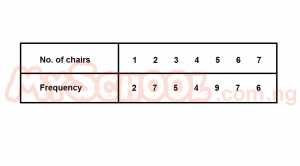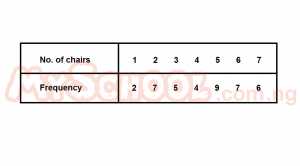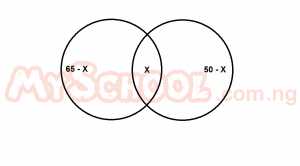Year :
1991
Title :
Mathematics (Core)
Exam :
WASSCE/WAEC MAY/JUNE
Paper 1 | Objectives
31 - 40 of 50 Questions
| # | Question | Ans |
|---|---|---|
| 31. |
P = {2, 1,3, 9, 1/2}; Q = {1,21/2,3, 7} and R = {5, 4, 21/2}. Find P∩Q∩R A. (21/2) B. ∅ C. (1, 3, 7) D. (4) E. (5,7,9) |
B |
| 32. |
In a class of 80 students, every student had to study Economics or Geography or both Economics and Geography. lf 65 students studied Economics and 50 studied Geography, how many studied both subjects? A. 15 B. 30 C. 35 D. 45 E. 50 Detailed Solution
80 = 65 - x + x + 50 - x x = 35 |
|
| 33. |
Which of the following is not a measure of dispersion? A. Mode B. Mean deviation C. Range D. interquartile range E. Standard deviation |
A |
| 34. |
The mean of 30 observations recorded in an experiment is 5. lf the observed largest value of 34 is deleted, find the mean of the remaining observations A. 5 B. 4 C. 3.9 D. 3.4 E. 3.0 Detailed Solutionx = 5, \(\frac{\sum {fx}}{\sum {f}}\) =5= \(\frac{\sum {fx}}{30}\) \(\sum {fx}\) = 5 x 30 = 150; 150 - 34 = 116 \(\sum {f}\) = 29 \(\sum {fx}\) = 116 = \(\frac{116}{29}\) = 4 |
|
| 35. |
 Find the mean of the distribution A. 3.5 B. 4.0 C. 4.4 D. 5.0 E. 5 Detailed Solution\(\bar{x}\) = \(\frac{2 + 14 + 15 + 16 + 45 + 42 + 42}{40}\) = \(\frac{176}{40}\) = 4.4 |
|
| 36. |
 Find the mode of the distribution A. 40 B. 9 C. 7 D. 5 E. 2 |
D |
| 37. |
 Find the median of the distribution A. 9 B. 6.5 C. 5 D. 4.5 E. 4 |
C |
| 38. |
If events X and Y are mutually exclusive, . P(X) = 1/3 and P(Y) = 2/5, P(X∩Y) is A. o B. 2/15 C. 11/15 D. 4/15 E. 1 Detailed SolutionP(X \(\cap\) Y) = \(\frac{1}{3} \times \frac{2}{5}\)= \(\frac{2}{15}\) |
|
| 39. |
If events X and Y are mutually exclusive, P(X) = 1/3 and P(Y) = 2/5, P(X∪Y) is A. o B. 2/15 C. 4/14 D. 11/15 E. 1 Detailed SolutionP(X \(\cup\) Y) = \(\frac{1}{3} + \frac{2}{5}\)= \(\frac{11}{15}\) |
|
| 40. |
A box contains 2 white and 3 blue identical marbles. If two marbles are picked at random, one after the other without replacement, what is the probability of picking two marbles of different colors? A. 2/3 B. 3/5 C. 2/5 D. 7/20 E. 3/10 Detailed SolutionTotal number of marbles = 5; 1st pick = 2/5 2nd pick = 3/4; 3rd pick = 3/5; 4th pick = 2/4∴ Probability of picking two marbles of different colors = (2/5 x 3/4) + (3/5 + 2/4) = 12/20 = 3/5 |
| 31. |
P = {2, 1,3, 9, 1/2}; Q = {1,21/2,3, 7} and R = {5, 4, 21/2}. Find P∩Q∩R A. (21/2) B. ∅ C. (1, 3, 7) D. (4) E. (5,7,9) |
B |
| 32. |
In a class of 80 students, every student had to study Economics or Geography or both Economics and Geography. lf 65 students studied Economics and 50 studied Geography, how many studied both subjects? A. 15 B. 30 C. 35 D. 45 E. 50 Detailed Solution
80 = 65 - x + x + 50 - x x = 35 |
|
| 33. |
Which of the following is not a measure of dispersion? A. Mode B. Mean deviation C. Range D. interquartile range E. Standard deviation |
A |
| 34. |
The mean of 30 observations recorded in an experiment is 5. lf the observed largest value of 34 is deleted, find the mean of the remaining observations A. 5 B. 4 C. 3.9 D. 3.4 E. 3.0 Detailed Solutionx = 5, \(\frac{\sum {fx}}{\sum {f}}\) =5= \(\frac{\sum {fx}}{30}\) \(\sum {fx}\) = 5 x 30 = 150; 150 - 34 = 116 \(\sum {f}\) = 29 \(\sum {fx}\) = 116 = \(\frac{116}{29}\) = 4 |
|
| 35. |
 Find the mean of the distribution A. 3.5 B. 4.0 C. 4.4 D. 5.0 E. 5 Detailed Solution\(\bar{x}\) = \(\frac{2 + 14 + 15 + 16 + 45 + 42 + 42}{40}\) = \(\frac{176}{40}\) = 4.4 |
| 36. |
 Find the mode of the distribution A. 40 B. 9 C. 7 D. 5 E. 2 |
D |
| 37. |
 Find the median of the distribution A. 9 B. 6.5 C. 5 D. 4.5 E. 4 |
C |
| 38. |
If events X and Y are mutually exclusive, . P(X) = 1/3 and P(Y) = 2/5, P(X∩Y) is A. o B. 2/15 C. 11/15 D. 4/15 E. 1 Detailed SolutionP(X \(\cap\) Y) = \(\frac{1}{3} \times \frac{2}{5}\)= \(\frac{2}{15}\) |
|
| 39. |
If events X and Y are mutually exclusive, P(X) = 1/3 and P(Y) = 2/5, P(X∪Y) is A. o B. 2/15 C. 4/14 D. 11/15 E. 1 Detailed SolutionP(X \(\cup\) Y) = \(\frac{1}{3} + \frac{2}{5}\)= \(\frac{11}{15}\) |
|
| 40. |
A box contains 2 white and 3 blue identical marbles. If two marbles are picked at random, one after the other without replacement, what is the probability of picking two marbles of different colors? A. 2/3 B. 3/5 C. 2/5 D. 7/20 E. 3/10 Detailed SolutionTotal number of marbles = 5; 1st pick = 2/5 2nd pick = 3/4; 3rd pick = 3/5; 4th pick = 2/4∴ Probability of picking two marbles of different colors = (2/5 x 3/4) + (3/5 + 2/4) = 12/20 = 3/5 |
